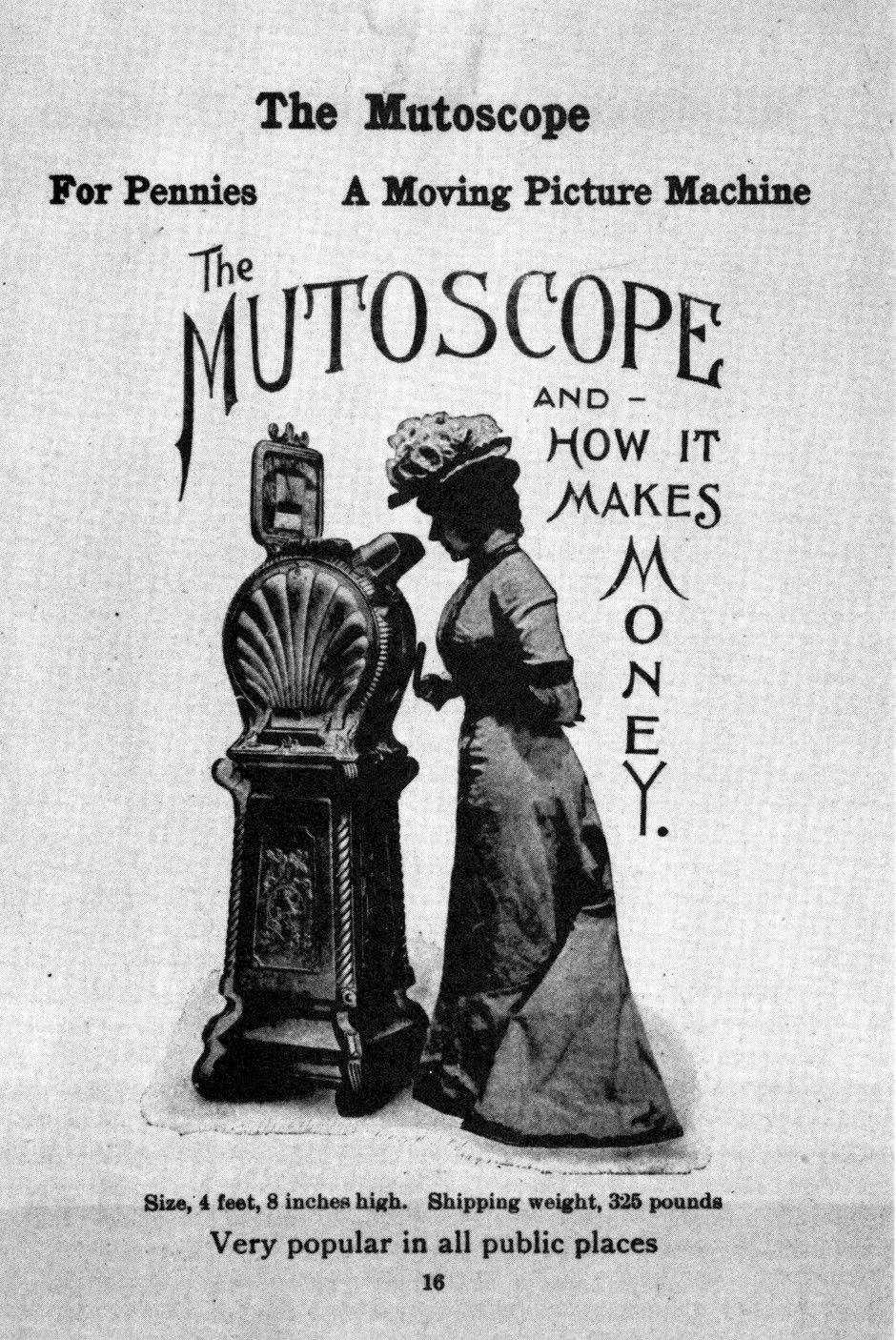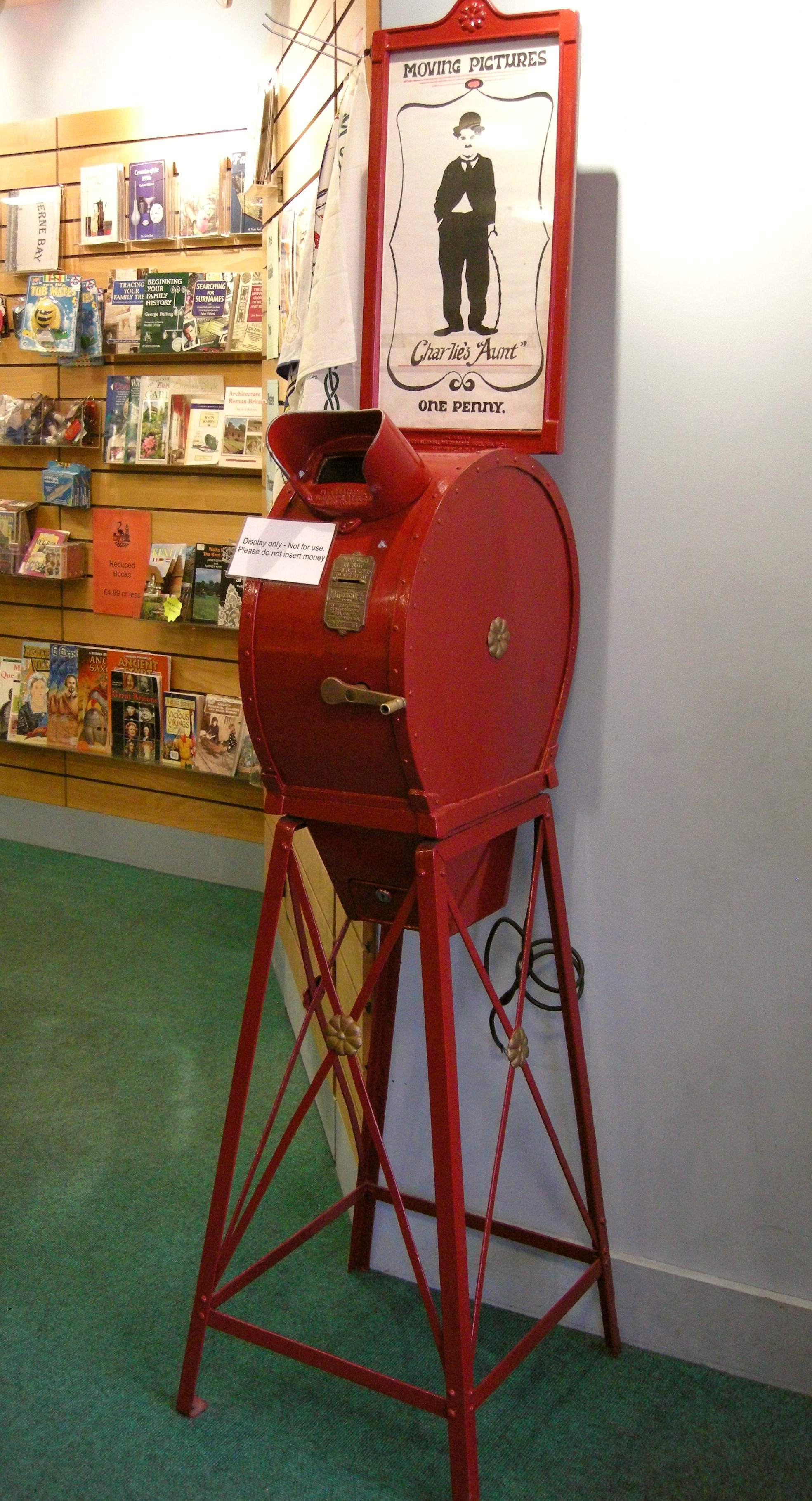Mutoscope on:
[Wikipedia]
[Google]
[Amazon]


 The Mutoscope is an early
The Mutoscope is an early
Illustration and demonstration of the Kinora''Penny Arcade''
poem by Jared Carter describes tightrope-walk images viewed through a Mutoscope. * * {{Precursors of film Audiovisual introductions in 1894 Film and video technology History of film Commercial machines Articles containing video clips


 The Mutoscope is an early
The Mutoscope is an early motion picture
A film also called a movie, motion picture, moving picture, picture, photoplay or (slang) flick is a work of visual art that simulates experiences and otherwise communicates ideas, stories, perceptions, feelings, beauty, or atmosphere ...
device, invented by W. K. L. Dickson and Herman Casler
Herman Casler (March 12, 1867 in Sandwich, Illinois – July 20, 1939 in Canastota, New York) was an American inventor and co-founder of the partnership called the K.M.C.D. Syndicate, along with W.K-L. Dickson, Elias Koopman, and Henry Marvin ...
and later patented by Herman Casler
Herman Casler (March 12, 1867 in Sandwich, Illinois – July 20, 1939 in Canastota, New York) was an American inventor and co-founder of the partnership called the K.M.C.D. Syndicate, along with W.K-L. Dickson, Elias Koopman, and Henry Marvin ...
on November 21, 1894. Like Thomas Edison
Thomas Alva Edison (February 11, 1847October 18, 1931) was an American inventor and businessman. He developed many devices in fields such as electric power generation, mass communication, sound recording, and motion pictures. These inventi ...
's Kinetoscope
The Kinetoscope is an early motion picture exhibition device, designed for films to be viewed by one person at a time through a peephole viewer window. The Kinetoscope was not a movie projector, but it introduced the basic approach that woul ...
, it did not project on a screen and provided viewing to only one person at a time. Cheaper and simpler than the Kinetoscope, the system, marketed by the American Mutoscope Company (later the American Mutoscope and Biograph Company
The Biograph Company, also known as the American Mutoscope and Biograph Company, was a motion picture company founded in 1895 and active until 1916. It was the first company in the United States devoted entirely to film production and exhibition, ...
), quickly dominated the coin-in-the-slot peep-show
A peep show or peepshow is a presentation of a live sex show or pornographic film which is viewed through a viewing slot.
Several historical media provided voyeuristic entertainment through hidden erotic imagery. Before the development of the c ...
business.
Operation
The Mutoscope works on the same principle as theflip book
A flip book, flipbook, flicker book, or kineograph is a booklet with a series of images that very gradually change from one page to the next, so that when the pages are viewed in quick succession, the images appear to animate by simulating moti ...
. The individual image frames are conventional black-and-white, silver-based photographic prints on tough, flexible opaque cards. The image on each card is made by contact printing
A contact print is a photographic image produced from film; sometimes from a film negative, and sometimes from a film positive or paper negative. In a darkroom an exposed and developed piece of film or photographic paper is placed emulsion s ...
each frame of the original 70 mm film. Rather than being bound into a booklet, the cards are attached to a circular core, similar to a huge Rolodex
A Rolodex is a rotating card file device used to store business contact information. Its name, a portmanteau of the words ''rolling'' and ''index'', has become somewhat genericized (usually as ''rolodex'') for any personal organizer performing th ...
. A reel typically holds about 850 cards, giving a viewing time of about one minute. The reel with cards attached has a total diameter of about ; the individual cards have dimensions of about .
Mutoscopes are coin-operated. The patron views the cards through a single lens enclosed by a hood, similar to the viewing hood of a stereoscope
A stereoscope is a device for viewing a stereoscopic pair of separate images, depicting left-eye and right-eye views of the same scene, as a single three-dimensional image.
A typical stereoscope provides each eye with a lens that makes the ima ...
. The cards are generally lit electrically, but the reel is driven by means of a geared-down hand crank. Each machine holds only a single reel and is dedicated to the presentation of a single short subject, described by a poster affixed to the machine.
The patron can control the presentation speed only to a limited degree. The crank can be turned in both directions, but this does not reverse the playing of the reel. The patron cannot extend viewing time by stopping the crank, because the flexible images are bent into the proper viewing position by tension applied from forward cranking. Stopping the crank reduces the forward tension on the reels causing the reel to go backward and the picture to move away from the viewing position. A spring in the mechanism turns off the light, and in some models closes a shutter which blocks the picture.
Manufacture
Mutoscopes were originally manufactured from 1895 to 1909 for the American Mutoscope Company, later American Mutoscope and Biograph Company (1899) by the Marvin & Casler Co., Canastota, New York formed by two of the founding Managers of American Mutoscope Company. In the 1920s the Mutoscope was licensed to William Rabkin who started his own company, theInternational Mutoscope Reel Company
The International Mutoscope Reel Company was an American amusement arcade company. They were formed in the early 1920s, to produce Mutoscope machines and the motion picture reels that the machines played. They continued to manufacture arcade mac ...
, which manufactured new reels and also machines from 1926 until 1949.
The term "Mutoscope" is no longer a registered trademark in the United States.
Usage
Mutoscopes were a popular feature ofamusement arcades
An amusement arcade (often referred to as a video arcade, amusements or simply arcade) is a venue where people play arcade games, including arcade video games, pinball machines, electro-mechanical games, redemption games, merchandisers (such as cl ...
and pleasure piers in the UK until the introduction of decimal coinage in 1971. The coin mechanisms were difficult to convert, and many machines were subsequently destroyed. Some were exported to Denmark where pornography had recently been legalised. The typical arcade installation included multiple machines offering a mixture of fare. Both in the early days and during the revival, that mixture usually included "girlie" reels which ran the gamut from risqué to outright soft-core pornography. It was common for these reels to have suggestive titles that implied more than the reel actually delivered. The title of one such reel, '' What the Butler Saw'', became a by-word, and Mutoscopes are commonly known in the UK as "What-the-Butler-Saw machines." (What the butler saw, presumably through a keyhole, was a woman partially disrobing.)
Public response
''The San Francisco Call'' printed a short piece about the Mutoscope in 1898, which claimed that the device was extremely popular: "Twenty machines, all different and amusing views...are crowded day and night with sightseers." However, just a few months later, the same newspaper published an editorial railing against the Mutoscope and similar machines: "...a new instrument has been placed in the hands of the vicious for the corruption of youth...These vicious exhibitions are displayed in San Francisco with an effrontery that is as audacious as it is shameless." In 1899, ''The Times
''The Times'' is a British daily national newspaper based in London. It began in 1785 under the title ''The Daily Universal Register'', adopting its current name on 1 January 1788. ''The Times'' and its sister paper '' The Sunday Times'' ( ...
'' also printed a letter inveighing against "vicious demoralising picture shows in the penny-in-the-slot machines. It is hardly possible to exaggerate the corruption of the young that comes from exhibiting under a strong light, nude female figures represented as living and moving, going into and out of baths, sitting as artists' models etc. Similar exhibitions took place at Rhyl
Rhyl (; cy, Y Rhyl, ) is a seaside town and community in Denbighshire, Wales. The town lies within the historic boundaries of Flintshire, on the north-east coast of Wales at the mouth of the River Clwyd ( Welsh: ''Afon Clwyd'').
To the we ...
in the men's lavatory, but, owing to public denunciation, they have been stopped."
Notes
External links
Illustration and demonstration of the Kinora
poem by Jared Carter describes tightrope-walk images viewed through a Mutoscope. * * {{Precursors of film Audiovisual introductions in 1894 Film and video technology History of film Commercial machines Articles containing video clips